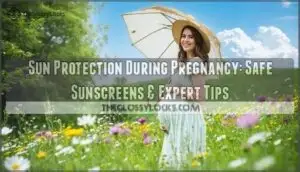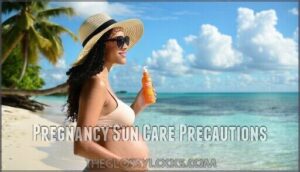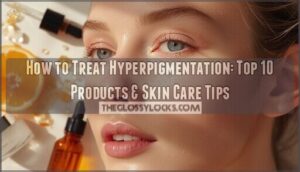This site is supported by our readers. We may earn a commission, at no cost to you, if you purchase through links.
 During pregnancy, your skin becomes up to twice as sensitive to UV damage due to hormonal changes that increase melanin production.
During pregnancy, your skin becomes up to twice as sensitive to UV damage due to hormonal changes that increase melanin production.
You’ll need broad-spectrum SPF 30+ sunscreen daily, with mineral options like zinc oxide and titanium dioxide being safest choices. These physical blockers sit on your skin’s surface rather than absorbing into your bloodstream.
Pregnancy hormones can trigger melasma – stubborn dark patches that may never completely fade, earning the nickname "pregnancy mask."
Don’t let fear of missing vitamin D stop you from protecting yourself; just 10-15 minutes of morning sun exposure provides adequate levels. Smart sun habits now prevent years of regret later, and the right sunscreen formula can make all the difference.
Table Of Contents
- Key Takeaways
- Sun Protection Basics
- Pregnancy Skin Changes
- Safe Sunscreen Options
- Sun Protection Tips
- Pregnancy Sun Care Precautions
- Frequently Asked Questions (FAQs)
- How can I stay safe in the sun while pregnant?
- What SPF should be avoided in pregnancy?
- Can you wear sunscreen if you are pregnant?
- Can I use tanning beds safely while pregnant?
- How does pregnancy affect sunburn healing time?
- Are spray tans safe during pregnancy?
- Should I avoid certain outdoor activities when pregnant?
- Can sun exposure affect my babys development?
- Conclusion
Key Takeaways
- Your skin becomes twice as sensitive to UV damage during pregnancy due to hormonal changes, making daily broad-spectrum SPF 30+ sunscreen essential to prevent permanent dark patches called melasma.
- Choose mineral sunscreens with zinc oxide or titanium dioxide over chemical formulas – they sit on your skin’s surface instead of absorbing into your bloodstream, providing safer protection for you and your baby.
- Layer your protection by combining sunscreen with wide-brimmed hats, protective clothing, and seeking shade during peak UV hours (10am-4pm) to reduce exposure by up to 60%.
- Apply sunscreen generously using one ounce for your entire body and reapply every two hours – most people only use 25% of the recommended amount, leaving skin vulnerable to damage.
Sun Protection Basics
You need sun protection during pregnancy because your changing hormones make your skin more sensitive to UV damage.
Daily sunscreen use prevents skin cancer and reduces your risk of developing pregnancy-related dark spots called melasma.
Importance of Sunscreen
Every pregnancy brings unique skin changes that make sunscreen essential for both mother and baby’s health.
Dermatological care during pregnancy requires consistent UV defense to prevent hyperpigmentation and skin damage.
Safe sunscreen provides vital skin protection while supporting your body’s changing needs. Choose broad-spectrum formulas with pregnancy-safe ingredients for maximum sunscreen benefits and effective sun protection during pregnancy.
Understanding the skin type requirements is essential for selecting the right sunscreen for pregnant women, ensuring broad-spectrum protection and effective sun defense.
UV Radiation Effects
UV radiation from the sun contains UVA and UVB rays that penetrate your skin, causing immediate cellular harm and DNA damage.
During pregnancy, your skin becomes more vulnerable to radiation exposure due to hormonal changes.
UVB rays primarily affect the skin’s surface, while UVA rays penetrate deeper, accelerating skin aging.
Both types increase UV intensity effects, making sun protection during pregnancy essential for preventing long-term damage, which is why preventing long-term damage is crucial.
Skin Cancer Risks
Prolonged sun exposure dramatically increases your melanoma risk and accelerates UV damage to vulnerable skin cells.
During pregnancy, heightened skin sensitivity makes cancer prevention even more critical for expectant mothers.
Your skin cancer risks include:
- Melanoma – the deadliest form, spreading rapidly through your body
- Basal cell carcinoma – creating painful, persistent skin lesions
- Squamous cell carcinoma – potentially metastasizing to lymph nodes
- Actinic keratoses – precancerous patches signaling cellular damage
- Cumulative DNA damage – building silently with each unprotected moment
Establishing a thorough pregnancy skincare routine with proper sun protection factor substantially reduces these threats while safeguarding both you and your developing baby.
Pregnancy Skin Changes
Your body undergoes significant hormonal changes during pregnancy that make your skin more vulnerable to sun damage.
These shifts increase melanin production and skin sensitivity, putting you at higher risk for dark patches and pigmentation issues that can become permanent without proper protection.
Hormonal Effects on Skin
Pregnancy brings dramatic hormone fluctuations that transform your skin’s behavior.
Rising estrogen and progesterone levels increase melanocyte-stimulating hormone production, making your skin hypersensitive to UV exposure.
These hormonal shifts trigger melasma development and widespread hyperpigmentation affecting up to 90% of expectant mothers.
The estrogen impact particularly intensifies during the first trimester, setting the stage for sun-related complications without proper pregnancy skin care protection.
Understanding hormonal skin changes is essential for managing pregnancy-related skin issues.
Increased Sun Sensitivity
Your skin becomes a solar sponge during pregnancy, absorbing UV rays more readily than before.
Hormonal surges amplify your skin’s vulnerability, making sun protection during pregnancy non-negotiable for sensitive skin.
Here’s what increases your UV exposure risk:
- Estrogen spikes thin your skin’s protective barrier
- Blood vessels dilate closer to surface
- Melanocyte activity jumps 20-30%
- Heat protection mechanisms weaken
- Skin reactions occur faster with less sun
Smart sunscreen alternatives include zinc oxide and titanium dioxide – your skin’s best friends now.
Melasma and Hyperpigmentation
Melasma affects up to 90% of pregnant women, creating dark patches on your face known as the "pregnancy mask."
This Skin Discoloration occurs when hormones trigger excessive melanin production.
Hyperpigmentation worsens with sun exposure, making diligent sun protection during pregnancy non-negotiable.
These brown patches typically appear on cheeks, forehead, and upper lip areas.
Safe Sunscreen Options
When choosing sunscreen during pregnancy, you’ll want to focus on mineral-based formulas containing zinc oxide or titanium dioxide rather than chemical alternatives.
These physical blockers sit on your skin’s surface and provide immediate protection without absorbing into your bloodstream, acting as physical blockers.
Chemical Vs Physical Sunscreens
When choosing sunscreen during pregnancy, you’ll encounter two main types with distinct mechanisms.
Chemical sunscreens absorb UV radiation, while physical sunscreens create a protective barrier using mineral actives.
Key differences between chemical and physical sunscreens:
- UV Filters: Chemical versions use avobenzone and oxybenzone; physical rely on zinc oxide and titanium dioxide
- Skin Penetration: Chemical ingredients absorb into bloodstream; mineral sunscreen stays on surface
- Sunscreen Stability: Physical formulas remain stable longer; chemical types may degrade faster
- Nano Particles: Some mineral sunscreens use micronized particles for better cosmetic feel
- Application Time: Physical sunscreen works immediately; chemical requires 15-minute absorption period
Physical sunscreens offer superior safety during pregnancy due to minimal systemic absorption and proven ingredient profiles.
To make an informed decision, understanding the differences between chemical vs physical sunscreens is necessary.
SPF and Broad-Spectrum Protection
Understanding SPF ratings and broad-spectrum protection helps you make informed sunscreen choices.
Look for SPF 30 or higher, which blocks 97% of UVB rays. Broad-spectrum formulas protect against both UVA and UVB radiation.
Higher SPF ratings don’t dramatically increase protection—SPF 50 blocks 98% versus SPF 30’s 97%.
Focus on consistent reapplication every two hours for ideal skin protection during pregnancy.
When selecting a sunscreen, consider the importance of broad spectrum protection for thorough defense against harmful rays.
Pregnancy-Safe Ingredients
Zinc oxide and titanium dioxide stand as the gold standard for sun protection during pregnancy.
These mineral actives create a protective shield on your skin’s surface without absorbing into your bloodstream.
Look for gentle formulas featuring:
- Non-nano zinc oxide that sits on skin like armor
- Fragrance-free options that won’t trigger pregnancy sensitivity
- Broad-spectrum protection blocking both UVA and UVB rays
These safe chemicals offer immediate protection for expectant mothers. When choosing a sunscreen, consider the importance of pregnancy safe options to guarantee the best results with broad-spectrum protection.
Sun Protection Tips
Beyond sunscreen, you’ll need multiple layers of protection to shield your changing skin from harmful UV rays.
Smart clothing choices, strategic shade-seeking, and proper application techniques work together to create thorough sun safety during pregnancy, which involves thorough sun safety measures.
Clothing and Accessories
Layer up with protective clothing that doubles as your first line of defense.
Wide-brimmed hats shield your face and neck from harmful rays while sunglasses protect delicate eye areas. Choose breathable fabrics with tight weaves that block UV penetration.
Scarves offer extra neck coverage, and umbrellas provide instant portable shade. Don’t forget lip balm with SPF protection for complete coverage.
When selecting hiking attire, consider the importance of UPF rated clothing to guarantee maximum protection against UV rays.
Seeking Shade and Avoiding Peak Sun
Timing your outdoor activities makes all the difference for sun protection during pregnancy.
Plan outings before 10 a.m. or after 4 p.m. when UV radiation drops substantially.
During peak hours between 10-4, seek shade under trees, umbrellas, or covered areas.
Check the UV Index daily – readings above 3 require extra caution.
These smart sun timing strategies reduce your exposure by up to 60% while keeping summer safety manageable.
Applying Sunscreen Correctly
Proper sunscreen application makes the difference between genuine sun protection during pregnancy and false security.
Most people apply only 25% of the recommended amount, leaving skin vulnerable to UV damage.
- Apply generously: Use one ounce (two tablespoons) for your entire body, reapplying every two hours
- Check product labels: Choose broad-spectrum SPF 30+ formulas specifically tested for pregnancy safety
- Mind spray safety: Hold aerosol sunscreens six inches away and rub in thoroughly to avoid inhalation
Pregnancy Sun Care Precautions
Beyond sunscreen choices, you’ll need to take into account how pregnancy affects your sun exposure safety in other important ways.
Certain medications and your body’s changing vitamin D needs require special attention during these nine months, as they can impact your overall health and sun exposure safety.
Medication Interactions
Certain medications can amplify your skin’s vulnerability to UV damage during pregnancy, creating unexpected sun sensitivity.
Antibiotics like tetracyclines and fluoroquinolones dramatically increase sunburn risk, while antidepressants and antihistamines may trigger delayed skin reactions.
It’s vital to weigh safe skincare options when choosing products during pregnancy to minimize potential interactions.
| Medication Type | Sun Sensitivity Risk | Pregnancy Considerations |
|---|---|---|
| Antibiotics | High – severe burns possible | Monitor for drug reactions |
| Antidepressants | Moderate – UV sensitivity | Chemical reactions likely |
| Antihistamines | Variable – delayed rashes | Sunscreen interactions possible |
| Diuretics | Moderate – easier burning | Pregnancy risks elevated |
| Statins | Low-moderate – increased burn risk | Medication safety priority |
Always discuss medication safety with your healthcare provider before sun exposure.
Vitamin D and Sun Exposure
Your body walks a tightrope between getting enough vitamin D and protecting your skin.
While sunlight produces most vitamin D naturally, pregnancy increases your UV sensitivity and folate breakdown risks.
Safe sun exposure of 15-30 minutes several times weekly can boost vitamin D levels without compromising pregnancy nutrition.
However, supplementation with 400-1,000 IU daily often proves more reliable than relying on sun exposure alone.
Check the UV index before heading outdoors – moderate exposure beats the extremes.
Smart sun protection during pregnancy means balancing these competing needs while prioritizing both maternal and fetal health through evidence-based pregnancy sun care strategies.
Frequently Asked Questions (FAQs)
How can I stay safe in the sun while pregnant?
Pregnancy’s sunshine dance requires smart moves.
Use broad-spectrum SPF 30+ sunscreen, reapplying every two hours.
Seek shade between 10am-4pm, wear protective clothing and wide-brimmed hats, and stay hydrated to prevent overheating complications.
What SPF should be avoided in pregnancy?
No specific SPF levels should be avoided during pregnancy.
All sunscreen ingredients approved by the FDA are considered safe.
You can confidently use any SPF 30 or higher sunscreen to protect yourself and your baby.
Can you wear sunscreen if you are pregnant?
Like a protective shield guarding your growing baby, sunscreen is absolutely safe and essential during pregnancy.
You can confidently wear mineral or chemical sunscreens throughout all trimesters without harming your developing child, as they are essential.
Can I use tanning beds safely while pregnant?
No, you shouldn’t use tanning beds while pregnant.
UV radiation increases skin cancer risk and overheating can harm your developing baby.
Pregnancy hormones also make you more prone to dark patches and burns.
How does pregnancy affect sunburn healing time?
Surprisingly, sunburn healing time actually extends during pregnancy due to hormonal changes that slow cellular repair processes.
Your skin’s recovery mechanism becomes less efficient, meaning burns linger longer and require extra gentle care, which involves complete concepts of healing and extra gentle care to ensure proper recovery.
Are spray tans safe during pregnancy?
You’re considering spray tans but worried about inhalation risks. Avoid airbrush or spray-on tans during pregnancy – topical self-tanners with DHA are safer alternatives for that golden glow.
Should I avoid certain outdoor activities when pregnant?
Don’t let pregnancy clip your wings.
You can continue most outdoor activities with proper precautions.
Avoid high-impact sports, extreme temperatures, and activities with fall risks.
Listen to your body and stay hydrated.
Can sun exposure affect my babys development?
Moderate sun exposure during pregnancy is generally safe and won’t harm your baby’s development. However, pregnancy increases skin sensitivity, making you more prone to burns and melasma (dark facial patches).
Conclusion
Think of your skin as a delicate flower blooming during pregnancy – it needs extra protection to flourish.
Effective sun protection during pregnancy isn’t optional; it’s essential healthcare. Your heightened UV sensitivity and melasma risk make daily broad-spectrum SPF 30+ sunscreen critical.
Choose mineral formulas with zinc oxide or titanium dioxide for maximum safety. Combine sunscreen with protective clothing, shade-seeking, and proper application techniques.
These evidence-based strategies safeguard both maternal and fetal health throughout your pregnancy journey, ensuring daily broad-spectrum SPF 30+ sunscreen is used critically.
- https://www.webmd.com/baby/tanning-while-pregnant-what-to-know
- https://www.skinvision.com/articles/sun-exposure-when-pregnant-what-s-important-to-know
- https://pmc.ncbi.nlm.nih.gov/articles/PMC9580751/
- https://www.ahajournals.org/doi/10.1161/JAHA.120.020246
- https://aeroflowbreastpumps.com/blog/pregnancy-safe-sunscreen











